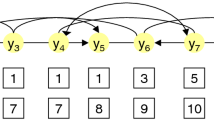Abstract
Chinese shallow parsing is a difficult, important and widely-studied sequence modeling problem. CRFs are new discriminative sequential models which may incorporate many rich features. This paper shows how conditional random fields (CRFs) can be efficiently applied to Chinese shallow parsing. We employ using CRFs and HMMs on a same data set. Our results confirm that CRFs improve the performance upon HMMs. Our approach yields the F1 score of 90.38% in Chinese shallow parsing with the UPenn Chinese Treebank. CRFs have shown to perform well for Chinese shallow parsing due to their ability to capture arbitrary, overlapping features of the input in a Markov model.
Preview
Unable to display preview. Download preview PDF.
Similar content being viewed by others
References
Li, S., Liu, Q., Yang, Z.: Chunk Parsing with Maximym Entropy Principle. Chinese Journal of Computers 26(12), 1734–1738 (2003)
Zhang, Y., Zhou, Q.: Automatic identification of Chinese base phrases. Journal of Chinese Information Processing 16(16) (2002)
Zhou, Q., Sun, M., Huang, C.: Chunking parsing scheme for Chinese sentences. Chinese J. Computers 22(1), 1158–1165 (1999)
Zhao, J., Huang, C.: A transformation-based model for Chinese basenp recognition. Journal of Chinese Information Processing 13(2), 1–7 (1998)
Lafferty, J., McCallum, A., Pereira, F.: Conditional Random Fields: Probabilistic Models for Segmenting and Labeling Sequence Data. In: Proc. 18th International Conf. on Machine Learning (2001)
Sha, F., Pereira, F.: Shallow Parsing with Conditional Random Fields. In: Proceedings of Human Language Technology-NAACL, Edmonton, Canada (2003)
McCallum, A., Feng, F.-f.: Chinese Word Segmentation with Conditional Random Fields and Integrated Domain Knowledge (2003)
McCallum, A., Li, W.: Early results for named entity recognition with conditional random fields, Feature Induction and Web-Enhanced Lexicons. In: Proceedings of Seventh Conference on Natural Language Learning, CoNLL (2003)
Pinto, D., McCallum, A., Wei, X., Croft, W.B.: Table extraction using conditional random fields. In: Proc. of SIGIR, pp. 235–242 (2003)
Peng, F., McCallum, A.: Accurate information extraction from research papers. In: Proc. of HLT/NAACL (2004)
Ramashaw, L.A., Marcus, M.P.: Text chunking using transformation-based learning. In: Proceedings of the Third ACL Workshop on Very Large Corpora
Abney, S.: Parsing by chunks. In: Berwick, R.C., Abney, S.P., Tenny, C. (eds.) Principle-Based Parsing: Computation and Psycholinguistics, pp. 257–278. Kluwer Academic Publishers, Boston (1991)
Paz, A.: Introduction to probabilistic automata. Academic Press, London (1971)
Bottou, L.: Une approche theorique del’apprentissage connexionniste: Applications a la reconnaissance de la parole, Doctoral dissertation, Universite de Paris XI (1991)
Ratnaparkhi, A.: A maximum entropy model for part-of-speech tagging. In: Proc. EMNLP. Association for Computational Linguistics, New Brunswick (1996)
Punyakanok, V.: The use of classifiers in sequential inference. NIPS 13 (2001)
Wallach, H.: Efficient Training of Conditional Random Fields, Thesis. Master of Science School of Cognitive Science, Division of Informatics. University of Edinburgh (2002)
McCallum, A., Freitag, D., Pereira, F.: Maximum entropy Markov models for information extraction and segmentation. In: Proc. ICML 2000, Stanford, California, pp. 591–598 (2000)
McCallum, A.K.: MALLET: A Machine Learning for Language Toolkit. (2002), http://mallet.cs.umass.edu
Yao, T., et al.: Natural Language Processing – A research of making computers understand human languages. Tsinghua University Press, Beijing (2002) (in Chinese)
Author information
Authors and Affiliations
Editor information
Editors and Affiliations
Rights and permissions
Copyright information
© 2005 Springer-Verlag Berlin Heidelberg
About this paper
Cite this paper
Tan, Y., Yao, T., Chen, Q., Zhu, J. (2005). Applying Conditional Random Fields to Chinese Shallow Parsing. In: Gelbukh, A. (eds) Computational Linguistics and Intelligent Text Processing. CICLing 2005. Lecture Notes in Computer Science, vol 3406. Springer, Berlin, Heidelberg. https://doi.org/10.1007/978-3-540-30586-6_16
Download citation
DOI: https://doi.org/10.1007/978-3-540-30586-6_16
Publisher Name: Springer, Berlin, Heidelberg
Print ISBN: 978-3-540-24523-0
Online ISBN: 978-3-540-30586-6
eBook Packages: Computer ScienceComputer Science (R0)




